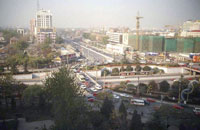
TRAVEL and tourism spending exceeded $6 trillion globally in 2005, according to the 2006 Tourism Satellite Accounting research released in March by the World Travel & Tourism Council (WTTC) and Accenture.
The data, announced at a meeting of WTTC members, reveal industry growth of 5.7 per cent from 2004 to 2005.
The Tourism Satellite Accounting (TSA) research, sponsored by Accenture and prepared by Oxford Economic Forecasting (OEF), includes reports of travel and tourism spending for 2005 as well as industry forecasts for 174 countries and the world.
The WTTC reported that various events, including the December 2004 tsunami and the 2005 bombings in London and Egypt, had local impact but did not materially affect global tourism.
“We are witnessing the power, speed and vitality of travel and tourism and how they can bring economic opportunity and jobs to people and economies seeking sustainable development,” said WTTC President, Jean-Claude Baumgarten.
WTTC worldwide forecasts for 2006 include:
• The industry is expected to grow 4.6 per cent (real terms), to total $6.5 trillion in 2006.
• The 10-year annualized growth (2007-2016) forecast is 4.2 per cent per annum, demonstrating an outlook for strong long-term growth.
• Visitor exports are expected to grow to nearly $900 billion in 2006 due to increases in international travel. This increase represents real growth of 6.5 per cent.
• The travel and tourism industry is expected to represent 3.6 per cent of total gross domestic product (GDP) in 2006. When considering both the direct and the indirect contributions to the world economy – e.g., including growth for tourism-related businesses, such as cleaning companies and caterers – the industry is expected to total 10.3 per cent of GDP in 2006.
• The global travel and tourism industry is expected to produce 2.5 million new jobs in 2006, comprising 76.7 million jobs, or 2.8 per cent of total world employment. When taking into account both the direct and indirect impact of the industry, Travel & Tourism are expected to create nearly 10 million new jobs globally, for a total of 234.3 million jobs or 8.7 per cent of total employment.
“Insight into how and where the travel and tourism industry is growing is critical for companies that want to improve their performance and take advantage of that growth, either in their own countries or around the world,” said Peter Franz, global managing director of Accenture’s Transportation and Travel Services practice. “As airlines, lodging companies and tour operators work to improve their bottom line, having usable data about both the industry and their own business is essential. The high performers will be those that can manage and use industry and customer data to make meaningful decisions.”
As part of the research, WTTC released its 2006 list of top ten trravel and tourism economies. For the third year in a row, Montenegro had the highest growth rate, as it continues to use the industry as a key to economic development and job creation. India and China placed second and third, respectively, illustrating the impact the emerging middle-class has on travel and tourism. Four central and eastern European countries – Romania, Croatia, Latvia and Albania – also joined the list.
“Global tourism activity is setting new records globally but what is really amazing is how smaller, developing countries like Montenegro, Romania, Namibia and Brunei are using travel and tourism as catalysts for broader economic development,” said Baumgarten. “They've come to appreciate the impact of international visitors and resident tourism and have made strategic decisions from the highest office to focus attention, resources and effort on the economic potential.”
Baumgarten continued, “Travel and tourism offer great opportunity for recovery to places like New Orleans, which suffered the devastation of Hurricane Katrina last summer. We saw the spirit of our industry in the pictures from Mardi Gras.”
